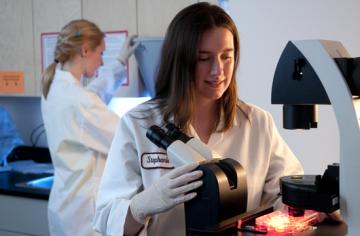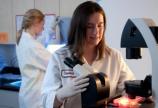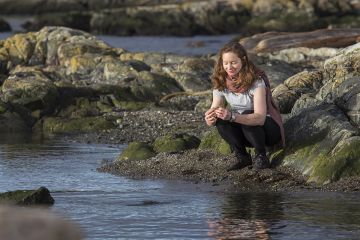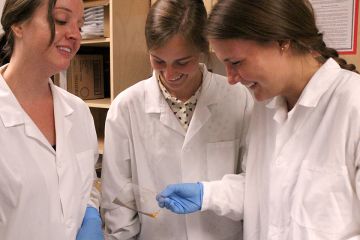Cells of hope: Stephanie Willerth's stem cell research
- Phil Saunders

When Stephanie Willerth was five years old she asked her parents for one of two things for Christmas—a chemistry set or a pair of tickets to a college bowl football game. “It wasn’t much of a choice since bowl tickets are pretty pricey, so they gave me the chemistry set,” says Willerth, who at 31 now has a much bigger “chemistry set”—a research lab at the University of Victoria.
As a biomedical engineer in UVic’s Department of Mechanical Engineering and Division of Medical Sciences, Willerth is making advances in a field that has huge medical potential—stem cell bioengineering.
Stem cells are special, powerful cells found in humans and other animals that can replicate into cells that can repair and replace damaged tissues. Stem cell research holds huge promise for the treatment of conditions such as cancer, Alzheimer’s and Parkinson’s diseases, diabetes, heart disease, and spinal cord injury.
But first, scientists need to know more about the biological signals that “tell” stem cells when and how to differentiate, and to find methods for growing and observing large numbers of the desired types of cells.
When Willerth was a graduate student in the US in 2006, her research group was the first to develop a method for studying stem cell behaviour in a 3-D setting. That work used embryonic stem cells, which are the most versatile at reproducing and creating tissue. But they also raise many difficult ethical and legal issues.
At UVic, Willerth and her team are exploring similar techniques using “pluripotent” adult stem cells, which have been altered to behave like embryonic stem cells.
In a recently published study, Willerth and undergraduate assistant Kathleen Kolehmainen used a highly concentrated mix of a naturally occurring blood protein to grow stem cells in an environment that most resembles a living body.
“Biologists traditionally work on cells in two dimensions,” she explains. “The cells we’re working with are being suspended in a 3-D environment, which is how they behave in the body, so we can see how they migrate, grow and differentiate to create tissue.”
Willerth, her students and research colleagues can now observe stem cells as they make the transition from cells to tissue and hopefully better understand the mechanics of the cell-tissue process. “The goal is for stem cell therapies to become more widely used for a larger range of applications,” she says.
Willerth is just as excited about the teaching potential of the demonstration video that accompanied the published paper. “My students can access the demo any time and replicate the process more easily. I don’t have to keep going back and showing them each step. They can just play the video again,” she says.
“The idea that we’re on the brink of helping people overcome so many different kinds of medical challenges is one of the most exciting aspects of my work,” says Willerth. “The fact that I can support the training of today’s young biomedical engineers to bring us closer to that day is what drives me. That—and this really nice chemistry set I get to work with every day.”
Faces of UVic Research video of Willerth describing her work
Photos
In this story
Keywords: biomedical engineering, research
People: Stephanie Willerth



